SKETCHES: Puzzling phenomena in hybrid Neochilenia. "Double" flower. Mutable mountain species "Colored" seedling of Aztekium
Nikolai Shemorakov
1. Puzzling phenomena in hybrid Neochilenia
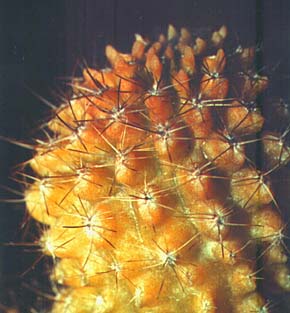 |
| Photo 1. |
In Cultivar #1 I have already reported on one of my "Chilean" hybrid (Neochilenia scoparia x Neochilenia odieri). To my great surprise, in the third year the red spots on one of the grafted plants had disappeared. On all the other grafts you could hardly see the green and in August of 2001 the grafted plants began dying one after another. Just before the plants perished their stems turned into watery substance. One could suppose it was a wet rot, but you couldn't see the primary hotbed of affection. Moreover after the colored grafts had died the stocks (Trichocereus) continued their lonely existence as if nothing had happened – they produced offsets readily and were not affected by any fungous diseases. All this was rather strange.
 |
| Photo 2. |
In September of 2001 I made an attempt to rescue an offset from the last surviving grafted plant. The offset seemed viable and was brightly colored (see photo 1: it shows the three-years-old plant two months before its end). When I tried to take hold of the offset it had crushed in my fingers – in fact the offset was very soft. Thus I had lost the last of my grafted plants.
There remained still the seedlings of the "Chilean" hybrid growing on their own roots. The plants grew very slowly and most of them were uncharacteristically colored for cacti (see photo 2). Soon they all died for no apparent reason at all.
These hybrids astounded me not only by their high lethality and slow growth. All the plants were multi-ribbed. They inherited this feature from their "father" (N. odieri) – an extremely rare occurrence among cacti in fact. There were more spines per areole in hybrid Neochilenia than in the mother plant (N. scoparia) but less spines than in the father plant (N. odieri).
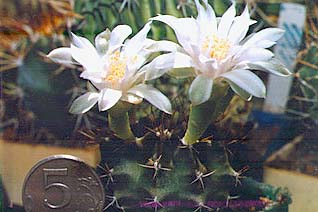 |
| Photo 3. |
The same is true for the spines' length – they were shorter than in the mother plant but longer than in the father plant. The hybrid did not inherit flattened stem of the parent plants though they were cultivated in identical conditions. I don't think grafting could change the stem form to such an extent: the grafted hybrid was 4 cm long and 2.5 cm in diameter – nothing in common with the parent plants. It's a pity but the plant didn't live long enough to flower, therefore there's nothing I can say about the attributes of this hybrid's flower.
I have no answers to many questions. Why did this hybrid die in the very prime of its life? What is the main reason for its end? Could it be the ultra-violet irradiation of the seeds after they were sown? Why do all these unhappy events happen in August and September? Could it be that the Chilean plants "remember" about seasons change?
2. "Double" flower
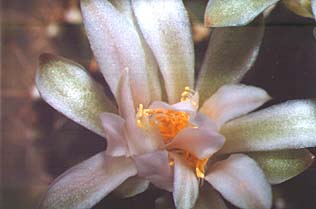 |
| Photo 4. |
Many cacti growers are well familiar with anomalous stem development in some of their plants. But anomalous development of a cactus flower is a rare occurrence. Only few owners of crested cacti may state that they saw a crested flower "alive".
There also exist other anomalies in cacti flowers. Last summer such anomaly had developed in my collection. The seedlings of Gymnocalycium delaetii (G. schickendantzii v. delaetii), at least it was their catalog name, had appeared in March of 1998. The seedlings were pricked out hardly ever once a year and therefore grew quite slowly. In June only some of them had exceeded the size of a five-ruble coin (2.5 cm) and showed the buds.
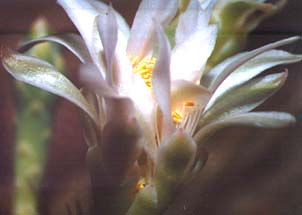 |
| Photo 5. |
One of the flowers surprised me by its unusual structure. The naked filaments, asymmetrically positioned petals and longitudinal slit (photo 3) made me examine this flower with special attention.
The inner row of petals was twisted clockwise in a spiral and divided the flower into two almost equal parts (photo 4). There was one pistil and its well-branching stigmas stayed in the larger part of the flower. You can see the middle part of the style in photo 5. There you can also distinguish the anthers of chaotically twisted stamens directed into the inner part of the flower tube.
 |
| Photo 6. |
Careful scrutiny of the flower tube revealed that the longitudinal slit runs through the two carpels dividing them into two non-symmetrical parts. There were no injured tissues on the edges of the split. Somewhere in the middle of the flower tube the split ended up branching into crinkles (photo 6).
I didn't manage to gather pollen from this plant because the anthers stayed underdeveloped until the flower withered (it stayed open for five days). I attempted to pollinate the flower with pollen of G. schickendantzii v. delaetii (true to description) but had no success.
The normal flower of this plant had a pistil with tightly closed stigmas and contained a great deal of pollen. I decided to pollinate it with the pollen from Gymnocalycium michoda. This time I had success; besides I pollinated G. michoda with the pollen gathered from the plant shown on photo 3. As a result both of the plants bore fruits. Before the fruits ripen or be sown it is impossible to determine whether the seeds they contain are hybrid or there happened self-pollination due to stimulating influence of strange pollen. I will report the results.
It is obvious that the plant shown on photo 3 is a subspecies of Gymnocalycium mihanovichii or an interspecies hybrid of this taxon and has no relation whatever to the G. schickendantzii group.
3. A mutable mountain species
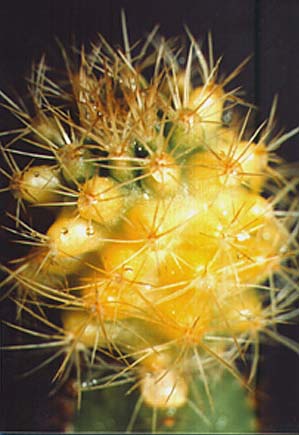 |
| Photo 7. |
In March of 1998 I had sown the seeds of Submatucana myriacantha. The seedlings sprouted on the 3rd day but developed rather slowly. In a year I had grafted two of the seedlings on Cereus peruvianus 2 cm high.
Having been grafted the stubborn plants began developing larger spines and grew in size considerably, but one of the grafted plants had "decided" to become three-headed and the other had brightened and turned light-green.
In summer of 2000 the light-green grafted plant started growing white and turned clear yellow-green. In summer of 2001 the bigger part of the stem was colored bright yellow, the base of the scion remained yellow-green and only the top of the plant stayed light-green (photo 7).
Thus the seedlings which were in no way peculiar after having been grafted revealed pretty quickly their concealed mutated genes.
4. "Colored" seedling of Aztekium
In August of 2001 I had sown the seeds of Aztekium ritteri I received from Dmitry Rogatzkin. Before sowing in order to disinfect the seeds I irradiated them with UV-rays using a physiotherapy equipment Q-145 by "Medicor" company. Not planning to induct plastid mutations in the seedlings I irradiated the seeds 30 minutes from 25 cm distance, in addition I turned them over 3 times with an annealed steel needle in order to eradicate possible fungi spores.
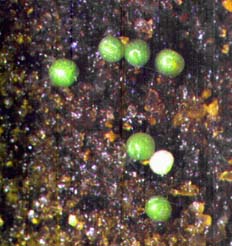 |
| Photo 8. |
After such a treatment the seeds were at once sown onto the sterilized mixture consisting of sand, leaf-mould and peat mixed in 6:2:1 ratio. The first sprouts appeared 4 days after the seeds were sown. They were uncolored as is typical for the most cacti, but one of the seedlings did not turn green in a day or two as the others. It remained uncolored or to be exact light-yellow (photo 8) and the color didn't develop even 6 days after the seedling's appearance. This seedling stopped growing on the 4th day after its "birthday" and on the 8th day it died for no apparent reason at all. I didn't even try to graft this tiny plant since I knew beforehand that it was not up to my skills. Though it would be exciting to observe a grown-up Aztekium with little chlorophyll.
It is interesting to note that the seeds of Blossfeldia liliputana treated and sown in the same manner gave no seedlings with little chlorophyll.





